Trout River Fishing In The Summer: FULL ARTICLE
Although catching trout in the summer can be very tought, as an experienced fishing guide, I know that with the right tactics and knowledge, summer trout fishing in rivers can be very good.
If you want to be consistent, these are some of the things I do to keep my clients catching big trout all summer.
- Water Temperatures: Be aware of water temperatures. Above 67F is often poor fishing. When the water temps go above 67, there are areas and times when the water temps can be better.
- Fish Dawn and Dusk: Dawn is when the water temps are coolest, and this is usually when I catch the most and the biggest trout.
- Stealth Is Key: Summertime means low and clear water, and trout are overly cautious. Use my tips for going undetected.
- Small Baits, Lures, And Flies: Because of the low clear water, I have found that smaller and less intrusive baits and lures are best. However, if small doesn’t work first, I will go big.
- Handle The Trout Properly: Warm water can stress the tour out, so if you plan to release your trout, play them to the net quickly, keep them submerged in the net while getting the hooks out, and if you need a picture, do it in less than 30 seconds. Get them back in the water fast.
When summer trout fishing in rivers, anglers should be aware of water temperatures which can greatly affect trout feeding behaviors. Trout fishing in the summer also requires different tactics, baits, and lures, as well as targeting the trout at select times of the day. Trout will even hold in different spots.
In my experience chasing summer trout for 36 years, I know that trout streams and rivers that hold trout during the spring will still harbor them throughout the summer, too, however, those some trout can migrate, or hold in different areas than they did in the spring.
After seeing studies from local expert biologists, I know that trout migration patterns are important to understand because on some rivers trout can migrate over 20 miles from winter holding waters to find colder summer water.
Summer Trout Fishing In Rivers
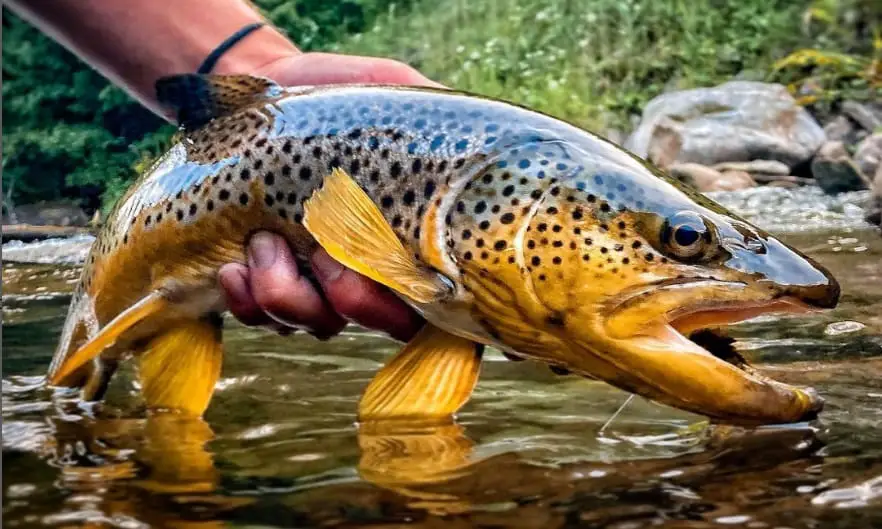
You might enjoy the warm weather during the summer months, but trout are cold-water species, and they won’t share your enthusiasm. Trout like their water cool and oxygenated and they tend to minimize their feeding activities when it becomes too hot.
For this reason, summer trout fishing in rivers requires a bit of extra know-how and these these should be taken into consideration.
- Time of day
- Location
- Finding cold water
- Food sources and activity
- Clearwater tactics.
- Bait or fly selection
How Does Weather Affect Trout Fishing In The Summer?
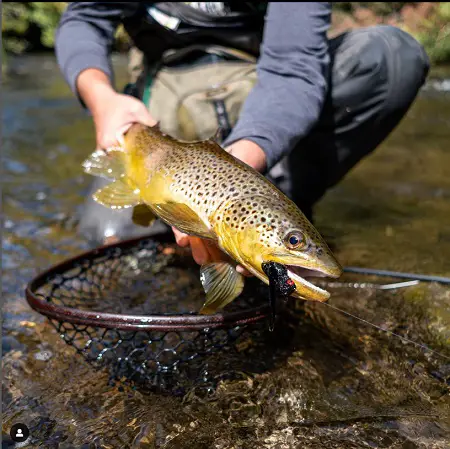
Trout fishing in the rivers is highly dependent on the weather. The weather, especially very hot and dry weather can raise water temperatures beyond what trout find comfortable.
If the air temperatures are very high for prolonged periods, trout might shut down as the water temps increase. If you want to beat the heat and have a successful fishing trip from June to September, you must use the weather to your advantage.
On some rivers, I have determined that summer time trout fishing is at its best immediately after rain. In fact, some of the biggest trout will feed heavily after a rain, and I and other smart anglers and guides will take advantage of this.
Why are summer rains good for trout fishing?
Heavy rains raise the water levels and dirty the water a bit which lowers the big trouts cautiousness. Rains also trigger runoff from fields and hills which wash food such as insects like ants and beetles into the river.
Heavy rains can also knock insects off leaves and grasses along the rivers and into the rivers. Heavy rains can also knock bugs right out of the air and into the river.
All this food at once can cause feeding frenzies for the small baitfish and the small trout, and then the big trout feed on the baitfish and other food drifting down the river, which makes an ideal opportunity for anglers to catch big fish.
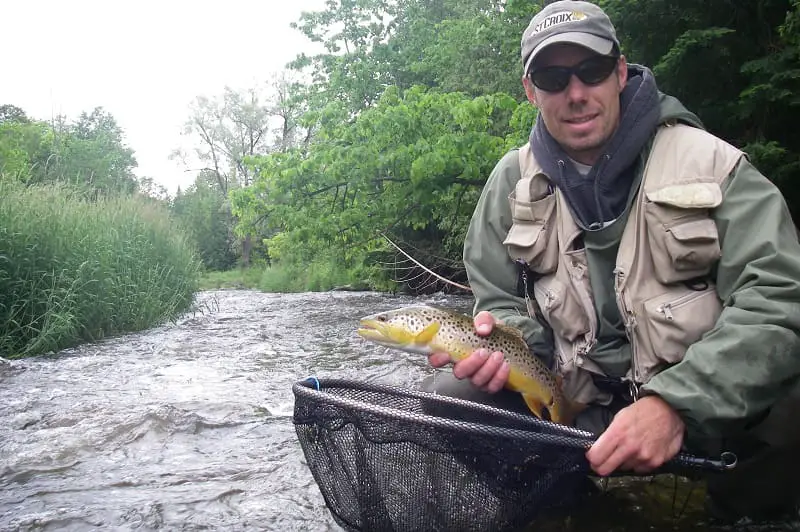
There is a downside to rain in the summer too, and it’s very important to know.
The downside to midday rain showers that occur during hot high sunny periods is that the ground surface can be very hot from the sun. Think of a hot road or driveway, sometimes it’s so hot you can’t even stand on it.
Now think of the rain falling on that hot surface which warms up the rainwater substantially and all that warm water eventually flows into the river which then raises water temperatures far above the trout’s temperature tolerance. When this happens it can shut the trout down and stop any feeding.
However, heavy rains that occur on cloudy days are far better than rains on sunny days because you don’t have that heating effect. Early morning rains when it’s still cool out can also be good as can nighttime rains. Some rivers that do not get a lot of runoff from rain will be less affected by warm rains.
Check out Trout Fishing In The Rain and Trout Fishing After The Rain.
What Is The Best Time Of Day For Catching Trout In Summer?
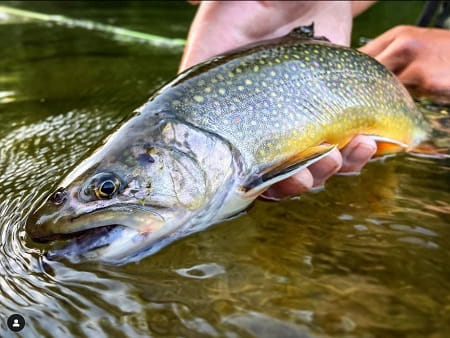
During the hot summer days, I find that trout are most active during the early morning hours and at dusk.
For this reason, all the guiding that I do in the summer is early in the morning, and I will adjust my fishing schedule and go out either early in the morning or just before dusk.
The water temperature is usually too high during the day and often by 11 am the trout feel stressed, and I’m done fishing.
It has been my experience that once the water temperature hits around 68F the trout naturally stop feeding anyways so you might as well not be there.
It’s not uncommon for me to check water temps every hour in the later morning and if I notice the trout activity levels have dropped it’s always because the water temps are 68F or above. This is when I either go find colder water ( I know some good spots) or I call it quits for the day.
Ofter, moving up river on spring fed river can provide colder water suitable for trout fishing. Smaller spring creeks and creeks and rivers with plenty of forest cover can remain cold all day.
Avoid fishing trout during the late morning or mid or late afternoon unless you check the water temps with a good stream thermometer.
If you do not have a stream Thermometer check out these ones:
- Orvis Encased Stream Thermometer
- White River Fly Shops Stream Thermometer
- Umpqua Stream Thermometer
Here is the trout fishing timetable you can use for reference when targeting trout in summer:
This is only a guideline based on air temps for anglers that do not have a stream thermometer. If you want to know what stream thermometer I use and recommend, check out my page River Fishing Gear: Everything You Need To Succeed
| Air temperature (Fahrenheit) | The best time of the day to fish trout |
| 61 to 65 °F | All Day or hen the insects are active |
| 66 to 70 °F | All Day or when the insects are active |
| 71 to 75 °F | 6 a.m. to 12 p.m. |
| 76 to 80 °F | 7 a.m. to 11 a.m. |
| 81 to 85 °F | Dawn to 11 a.m. |
| 86 to 89 °F | Dawn to 9 a.m |
As you can see, the hotter it is outside, the earlier you should fish. You should be at your spot during the first two hours from sunrise.
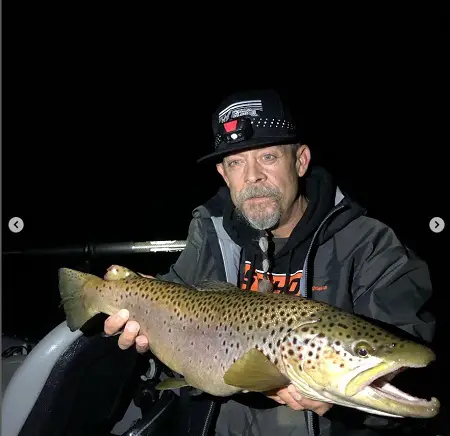
If you like to sleep longer, you can trout fish just before nightfall, too. As the sun lowers in the sky, the water temps will start to become colder, this is more true on spring-fed rivers and streams.
For the adventurous angler, night fishing for brown trout when the water is cool is a good way to get into some trophies. Brook trout and rainbows will also feed after dark. See Brown Trout Fishing At Night: Over 31 Expert Guide Tips.
As an example of how the sun affects the water temps. A local river that I fish and guide can be 70 to 75F from noon to 6 pm, but by 8 pm, it can be 66 – 67F, and by 6 am it can drop to 59 – 61F and is then perfect for fishing trout again.
This rise and drop temperature pattern can happen every day for months and the trout will feed only during these colder periods.
What Is The Ideal Water Temperature For Catching Trout In Summer?
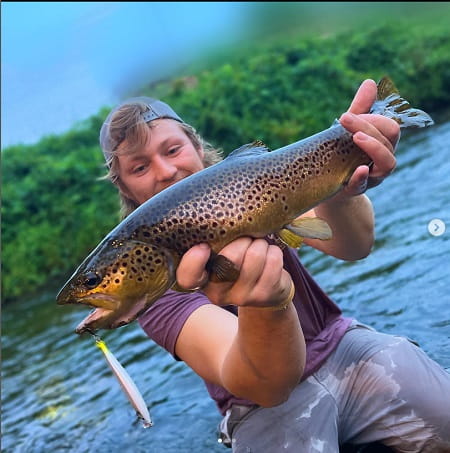
As I discussed, the temperature of the water has a direct influence on trout feeding patterns.
When water gets warmer, trout feed less actively or not at all, and it is harder or impossible for you to catch them. This is why many anglers give up on trout fishing during the summer.
In general, trout feed actively when the water temperature is between 40 and 70 degrees Fahrenheit. However, different types of trout tolerate different water temps.
For example, brook trout, bull trout, and cutthroat trout feed in colder waters than rainbow trout and might even feed well in 34 – 40 degrees Fahrenheit. Their preferred feeding temps are 40 to 60F.
Rainbow trout feed actively when the water temp is between 40 – 69 degrees. However, they prefer temperatures in the 52 – 64 degrees Fahrenheit range. Brown trout can tolerate slightly higher temperatures for prolonged periods than rainbow trout but their feeding temps are about the same.
One thing to note when discussing water temps is stability and the comfort of the trout.
While a trout might actively be feeding at 40F when the temperature is staying stable at that temperature, That same trout may not feed at 40F if the temperature has quickly dropped from 45 or 50 degrees.
Because trout are cold-blooded, their body temps match the water temps and a fast drop in temperature can slow their metabolism and their activity levels until their bodies adapt to the temperature. This is why in the winter the best time of day to fish is between 11 am and 3 pm when the water temps have risen or stabilized and trout are more active.
It would be wise to check the fishing regulations for the area you are targeting. Sometimes there are temperature-related fishing restrictions.
Best Summer Trout Rivers & Best Sections
Some rivers are better than others when it comes to staying cold in the summer, and some sections are better as well.
Spring Creeks
Spring creeks will have incoming water from springs whether that means groundwater upwellings in the river bed itself or incoming spring tributaries.
Either way, the spring water comes out of the ground year-round at around 55F which is great for trout. This is why spring creeks are often good rivers to fish during the summer.
Something to consider is that the upper reaches of spring creeks and some freestone creeks have the coldest water and therefore the upper sections might see trout migrating into them when the lower river water warms up too much.
I’ve seen radio tracking studies that show migrations of trout going up the river over 20 miles.
Tailwater Rivers
Tailwater rivers are rivers that have dams with a deep reservoir and the water from that reservoir goes under the dam and not over the dam. The water at the bottom of the reservoir is often very cold and will be more stable in both summer and winter.
For this reason, the survival of the trout is maximized and it’s why tailwater rivers can be the best rivers to fish in the summer and winter.
Catch-And-Release Summer Trout Fishing In Rivers
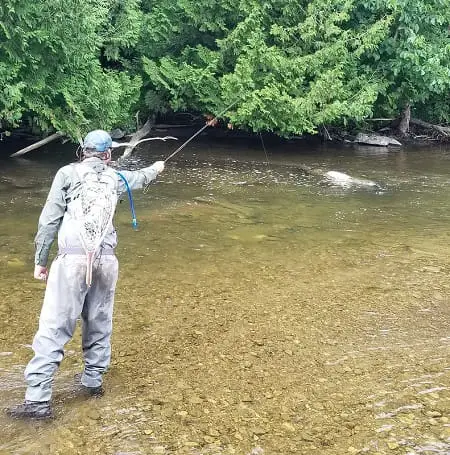
I have actually made many anglers angry because I guide on catch and release rivers for trout in very hot weather in the middle of the summer.
They believe that I am killing fish needlessly and that I should not fish in the summer. I believe they are wrong and I will explain why below.
Before you fish in the summer there are a few things you should do.
If you practice catch-and-release trout fishing in summer, you need to be extra careful not to hurt or kill the fish. Try to bring the trout into the net as soon as possible in warmer water. You should avoid playing with the fish long because it can become exhausted quite quickly in the warmer temps. Using slightly heavier leaders can help.
Fighting a fish for too long in warmer water can be fatal for the fish!
Try not to touch the trout too much and USE A NET. If you damage its protective layer with your hand or a glove, the trout can get infected with skin diseases easily. Keep the fish’s head in the water as much as you can, and release it as soon as possible.
AIR KILLS FISH! it is very important to keep the fish below the surface. 20 to 30 seconds out of the water for a photo is plenty. Do not drag fish up onto the bank if you plan to release them, leave them in the net and leave them below the surface.
A proper net is very important and I have a list of the best wading nets and how to attach them.
You can target trout until the water becomes too hot (67 – 70 degrees, depending on the type of fish). Fishing at higher temperatures is unethical since trout are likely to die from the stress even when you do everything right.
However, Even though the rivers near me can be 70 – 75F by mid-day during the summer, I still fish these rivers. I fish and guide them first thing in the morning when the river is back down to 59 – 63F. Doing so has allowed me and my clients to catch thousands of large trout all summer, and then release them healthy and safe.
How do I know they are healthy after release even when the air temps are over 30F? Simply because every year I will catch the same large trout over and over again. I have caught the same trout 20 times a summer even though the days I catch them the air temps are over 30F. I often will even catch them again the next summer.
Proper handling and releasing of trout are critical for their survival and so is paying close attention to water temps. This is why I ignore those anglers that get angry when river guides like fish and guide all summer.
What Are The Best Spots For Summer Trout Fishing In Rivers?
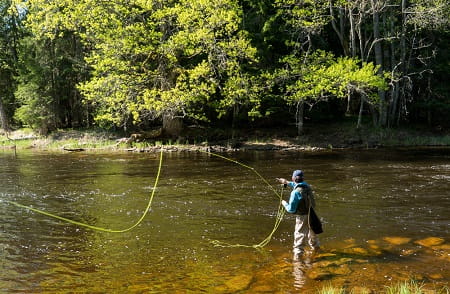
As you can probably assume, when fishing for trout in the summer, your goal is to find colder areas of the river. As temperatures rise, trout migrate into cooler water areas, usually upstream or around the feeder streams. I have seen many trout migrate 20 miles or more from their winter and spring spots to their late summer spots.
In summer, experienced anglers usually fish the first few miles of the upper river, some call this the headwaters of the river; you should do that, too.
Some trout will also hold just below where small cold incoming feeder creeks enter the main river. Some trout will even migrate up these feeder creeks in search of colder water where they can survive the summer heat.
Oxygen Levels For Summer Trout Fishing
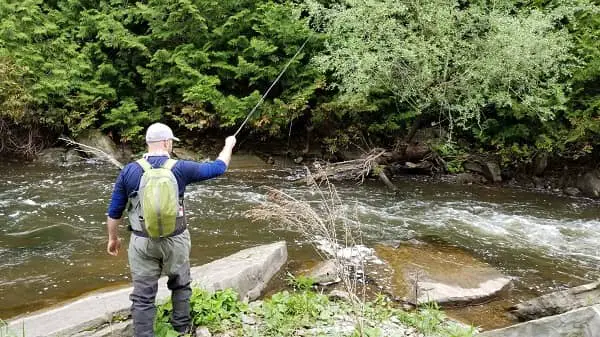
Oxygen also plays an important role in a trout’s life and it’s something that many anglers don’t understand.
Normally, colder water has more oxygen content than warmer water. Cold water is also denser and heavier than warmer water and it sinks or doesn’t rise, and therefore often the coldest and most oxygenated water will be in the deepest pools.
This is a great spot to target summer trout.
Some rivers just do not have deep spots so the trout don’t have the option of holding in deep cold water holes.
Instead, the best-oxygenated water is in the rapids and riffles and I have seen even big trout move out of slower and slightly deeper sections and move into 6 to 24 inches of fast water simply because the oxygen content is better. Anglers should start trying to fish fast water during the summer.
When summer trout fishing in rivers, you should try fishing spots such as:
- Deep holes at the foot of rapids
- Riffles and pocket water
- Obstructions breaking the current
- Waterfalls
- Shady or covered water areas
- Open water near undercut banks
Avoid popular, heavily-fished spots because trout have already been targeted for months by the time the summer season begins. They are thus probably more educated at avoiding getting caught.
Think outside the box and find new fishing spots – that will likely increase your chances of catching trout!
What Do Trout Eat In Summer?
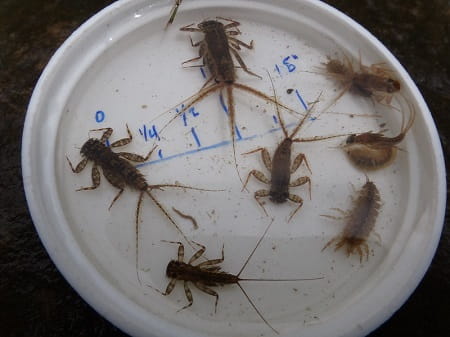
Trout mostly feed on aquatic and terrestrial insects, but they sometimes eat other fish, leeches, worms, and crustaceans, too.
In the summer, the emphasis is on the terrestrial (land-based) insects that fly onto the water or fall into it.
For example, grasshoppers are notoriously poor fliers, and they often end up as trout food during hot summer days.
What Is The Best Type Of Bait For Catching Trout In Summer?
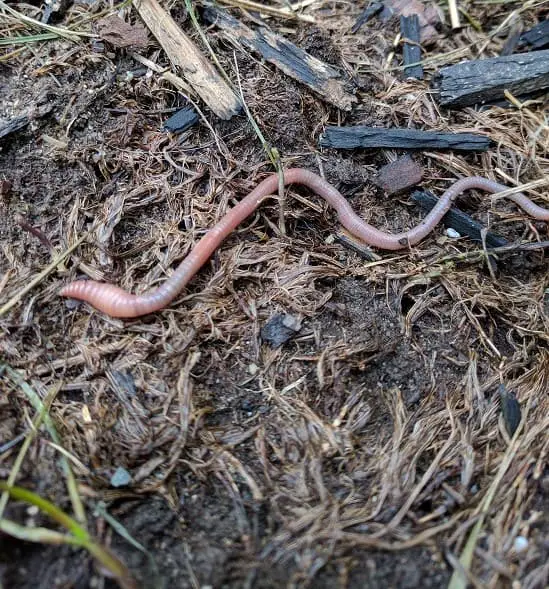
Having the right set of baits with you can make all the difference no matter the season. Your fishing technique determines the bait you are going to use.
You can also dangle a worm at the end of the setup but using the proper worm setup for rivers is important and I have found the right hook, combined with a small live worm or a plastic worm is best.
Worms might be fantastic in the spring when they are often found all over the place after spring rains, but during the summer, worms are not always as effective simply because they are less abundant.
But that doesn’t mean you shouldn’t try a worm, just don’t rely only on worms or you may end up catching nothing. I use many types of worms and show you my most effective types and how I rig them for the best success.
Some anglers will use egg-type boats like spawn bags, single eggs, and trout beads with good success during the summer. These baits will often work great in the spring but can be good in the summer too, but just like worms, don’t only fish eggs or you may not catch any trout. I tend to downsize all my egg baits during the summer.
Minnows, leeches, crawfish, grubs, maggots, and flies are also good options for summer trout fishing. For more information on the best baits, how to set them up, the best hooks for baits, best colors, and sizes, click the link.
What Is The Best Type Of Lure For Catching Trout In Summer?
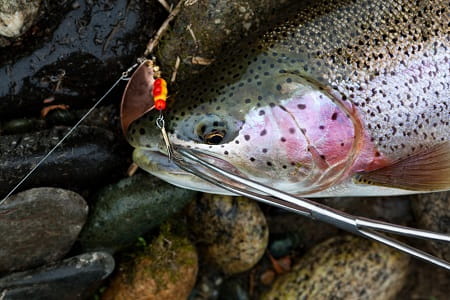
Trout are attracted by the lures that flutter and dart. You can thus try spinners, spoons, and crankbaits for summer trout.
See my tips and tactics on Lure Fishing For Trout.
If you fish from the riverbank on smaller rivers, opt for a small size 0 or 2 spinners but when fishing bigger rivers that require long casts, don’t be afraid to upsize to a 3# or #4 spinner, especially for casting baits in the early morning or late afternoon when the big trout are most active.
Try a Panther Martin or Mepps spinner – both have a good track record.
What Is The Best Type Of Flies For Catching Trout In Summer?
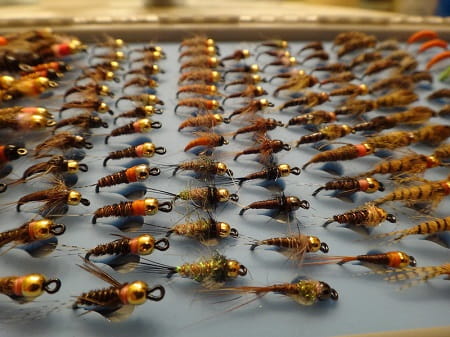
When there is a lot of trout action on the surface, you should best use a wet or dry fly.
When the trout are not feeding on the surface, flies that work best for catching trout in the summer are differently-colored Wooly Buggers and nymphs like Prince Nymphs. Check out my 29 Best Flies For Trout.
Flies are a very effective during the summer and you may not be a fly angler which is OK because flies can be effectively fished using spinning rods and reels too.
I will also often downsize my flies in the middle of the summer, or be sure that I match any current hatches going on. It’s always best to try and match what they are already feeding on.
The Best Fishing Tactics For Summer Trout Fishing In Rivers
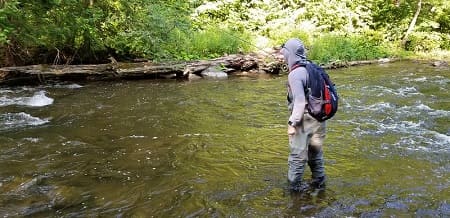
As we have already established, trout are not very active when temperatures rise. Therefore, they are highly unlikely to chase after food that is far away. They do not have the energy to do that!
It means that trout will wait for food to come to them. For this reason, you have to give your best to cover as much water as possible. You can fly fish, spin fish, or throw a lure – it is up to you, but you have to cover the water effectively!
Float fishing with a good bait below a float is a great method in deeper water over 3 feet deep. In shallower water than 3 feet your float can actually spook the trout.
Bottom bouncing is a very effective method for summer trout fishing in shallow runs, pockets, and riffles.
Fly fishing for trout is my favorite method and can be exceptionally effective if you know what you are doing.
If you are reading this pre-summer and are not in the heat of the summer yet and the trout are not on a summer bite, you might need to revert back to my spring trout fishing methods.
Summer Trout Fishing In Rivers Q&A
Summer trout fishing can be good if you know the when, where, and how. If you have a question, comment, or tips for catching trout in the summer, let us know in the comments section below.
Tight Lines,
Graham
